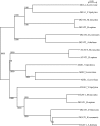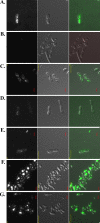Identification and characterization of DGA2, an acyltransferase of the DGAT1 acyl-CoA:diacylglycerol acyltransferase family in the oleaginous yeast Yarrowia lipolytica. New insights into the storage lipid metabolism of oleaginous yeasts
- PMID: 21808970
- PMCID: PMC3275733
- DOI: 10.1007/s00253-011-3506-x
Identification and characterization of DGA2, an acyltransferase of the DGAT1 acyl-CoA:diacylglycerol acyltransferase family in the oleaginous yeast Yarrowia lipolytica. New insights into the storage lipid metabolism of oleaginous yeasts
Abstract
Triacylglycerols (TAG) and steryl esters (SE) are the principal storage lipids in all eukaryotic cells. In yeasts, these storage lipids accumulate within special organelles known as lipid bodies (LB). In the lipid accumulation-oriented metabolism of the oleaginous yeast Yarrowia lipolytica, storage lipids are mostly found in the form of TAG, and only small amounts of SE accumulate. We report here the identification of a new DAG acyltransferase gene, DGA2, homologous to the ARE genes of Saccharomyces cerevisiae. This gene encodes a member of the type 1 acyl-CoA:diacylglycerol acyltransferase family (DGAT1), which has not previously been identified in yeasts, but is commonly found in mammals and plants. Unlike the Are proteins in S. cerevisiae, Dga2p makes a major contribution to TAG synthesis via an acyl-CoA-dependent mechanism and is not involved in SE synthesis. This enzyme appears to affect the size and morphology of LB, suggesting a direct role of storage lipid proteins in LB formation. We report that the Are1p of Y. lipolytica was essential for sterol esterification, as deletion of the encoding gene (ARE1) completely abolished SE synthesis. Unlike its homologs in yeasts, YlARE1 has no DAG acyltransferase activity. We also reconsider the role and function of all four acyltransferase enzymes involved in the final step of neutral lipid synthesis in this oleaginous yeast.
Figures







Similar articles
-
Three diacylglycerol acyltransferases contribute to oil biosynthesis and normal growth in Yarrowia lipolytica.Yeast. 2012 Jan;29(1):25-38. doi: 10.1002/yea.1914. Epub 2011 Dec 20. Yeast. 2012. PMID: 22189651
-
YALI0E32769g (DGA1) and YALI0E16797g (LRO1) encode major triacylglycerol synthases of the oleaginous yeast Yarrowia lipolytica.Biochim Biophys Acta. 2011 Oct;1811(10):587-96. doi: 10.1016/j.bbalip.2011.07.004. Epub 2011 Jul 19. Biochim Biophys Acta. 2011. PMID: 21782973 Free PMC article.
-
Molecular Characterization of the Elaeis guineensis Medium-Chain Fatty Acid Diacylglycerol Acyltransferase DGAT1-1 by Heterologous Expression in Yarrowia lipolytica.PLoS One. 2015 Nov 18;10(11):e0143113. doi: 10.1371/journal.pone.0143113. eCollection 2015. PLoS One. 2015. PMID: 26581109 Free PMC article.
-
Dynamics of neutral lipid storage in yeast.Acta Biochim Pol. 2004;51(2):323-47. Acta Biochim Pol. 2004. PMID: 15218532 Review.
-
Acyl-CoA:diacylglycerol acyltransferase: Properties, physiological roles, metabolic engineering and intentional control.Prog Lipid Res. 2022 Nov;88:101181. doi: 10.1016/j.plipres.2022.101181. Epub 2022 Jul 9. Prog Lipid Res. 2022. PMID: 35820474 Review.
Cited by
-
Role of Pex11p in Lipid Homeostasis in Yarrowia lipolytica.Eukaryot Cell. 2015 May;14(5):511-25. doi: 10.1128/EC.00051-15. Epub 2015 Mar 27. Eukaryot Cell. 2015. PMID: 25820522 Free PMC article.
-
Lipid biosynthesis in yeasts: A comparison of the lipid biosynthetic pathway between the model nonoleaginous yeast Saccharomyces cerevisiae and the model oleaginous yeast Yarrowia lipolytica.Eng Life Sci. 2016 Jul 7;17(3):292-302. doi: 10.1002/elsc.201600040. eCollection 2017 Mar. Eng Life Sci. 2016. PMID: 32624775 Free PMC article. Review.
-
Transcriptomic analyses during the transition from biomass production to lipid accumulation in the oleaginous yeast Yarrowia lipolytica.PLoS One. 2011;6(11):e27966. doi: 10.1371/journal.pone.0027966. Epub 2011 Nov 22. PLoS One. 2011. PMID: 22132183 Free PMC article.
-
An alternative angiosperm DGAT1 topology and potential motifs in the N-terminus.Front Plant Sci. 2022 Sep 16;13:951389. doi: 10.3389/fpls.2022.951389. eCollection 2022. Front Plant Sci. 2022. PMID: 36186081 Free PMC article.
-
Arabidopsis thaliana DGAT3 is a [2Fe-2S] protein involved in TAG biosynthesis.Sci Rep. 2018 Nov 22;8(1):17254. doi: 10.1038/s41598-018-35545-7. Sci Rep. 2018. PMID: 30467384 Free PMC article.
References
-
- Barth G, Gaillardin C. Yarrowia lipolytica. In: Wolf K, editor. Non conventional yeasts in biotechnology, a handbook. Berlin: Springer; 1996. pp. 313–388.
-
- Barth G, JM B, Dominguez A, Kerscher S, Ogrydziak D, Titorenko V, Gaillardin C. Functional genetics of Yarrowia lipolytica. In: dW JH, editor. Functional genetics of industrial yeasts, vol 1. Topics in current genetics. Berlin: Springer; 2003. pp. 227–271.
Publication types
MeSH terms
Substances
LinkOut - more resources
Full Text Sources
Other Literature Sources
Molecular Biology Databases

